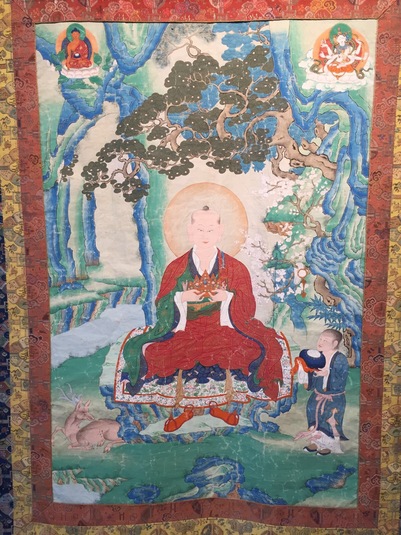
Item: Arhat/Sthavira (Buddhist Elder) - 16 Elders: Rahula
| Origin Location | Tibet |
|---|---|
| Date Range | 1700 - 1799 |
| Lineages | Sakya and Buddhist |
| Material | Ground Mineral Pigment on Cotton |
| Collection | Private |
Classification: Person
Appearance: Arhat
Gender: Male
Rahula, the Elder (Tibetan: ne ten, dra chen dzin, Sanskrit: Sthavira Rahula): the son of buddha Shakyamuni. Rahula is the 10th figure from the set of 16 Great Elders. This composition belongs to a twenty-three painting set. (See a similar painting from the Palace Museum in Beijing, HAR #34881).

'Arhat' is a Sanskrit term used incorrectly with reference to a group of sixteen Buddhist saints (lohan in Chinese). The correct Sanskrit term for these sixteen Buddhist figures is 'sthavira', meaning 'elder.' The term 'arhat' was popularized in the late 19th century by Western scholars.
Rahula, the Elder (Tibetan: ne ten, dra chen dzin, Sanskrit: Sthavira Rahula): the actual son of the buddha Shakyamuni and the 10th arhat from the set of sixteen Great Arhats. Rahula has a number of different ways in which he is depicted. The most common depiction in Tibetan art is for him to be holding up a jeweled crown with both hands. Chinese depictions often have him holding a staff in one hand and a tiger or lion seated at his feet. The iconography of the arhats is not fixed in art or religious literature.
"On the Island of Priyangku is the noble elder Rahula, surrounded by 1,100 arhats; homage to the One holding a jewelled tiara." (Sakya liturgical text).
At the top left side is an unidentified buddha figure likely from the group of Eight Medicine Buddhas or the Thirty-five Confession Buddhas. On the right side of the composition is the female deity of long-life Ushnishavijaya with three faces and eight hands.
(See Tibetan Religious Art (two volumes). Loden Sherab Dagyab. Otto Harrassowitz (1978). Chapter 35, pages 94 to 98).
Jeff Watt 8-2017
Arhat/Sthavira: Painting Masterworks (Miscellaneous)
Arhat/Sthavira: Rahula Main Page
Arhat/Sthavira: Rahula (Masterworks)
Arhat/Sthavira: Rahula (Yongle Model Figure)
Arhat/Sthavira: Rahula (Yongle Model Landscape)
